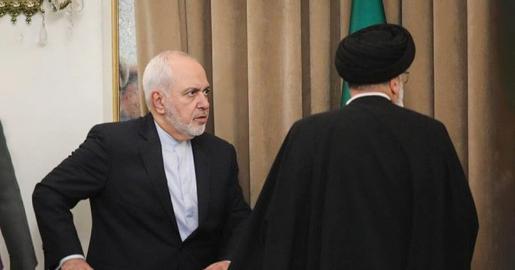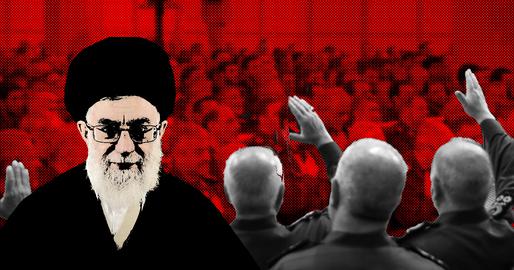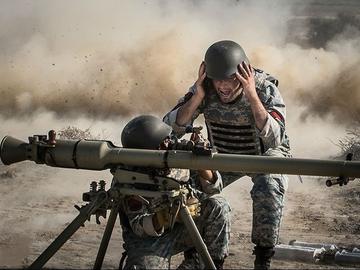On May 5, Ayatollah Khamenei’s official website published a photograph of a meeting between the supreme leader and senior officials of Hassan Rouhani’s administration. In the photograph, President Rouhani stands to the right of the supreme leader, who is seated. Both men are smiling, and Rouhani holds a pose that suggests deference.
The photograph is at odds with recent reports of exchanges between the two men — in fact, with reports of their relationship since Rouhani was elected as president in 2013. The tension between the two began at Rouhani’s swearing-in ceremony, when Khamenei announced that he supported the president’s view “that various issues must be handled with wisdom” — but then quickly warned that Iran had “enemies who fail to understand logic.” It was a signal that, when it came to foreign policy, the two men would not necessarily agree, as with so many issues defining Iranian politics today.
Then, a week before Rouhani’s inauguration, addressing university students, Khamenei took a somewhat different approach. He advised the students give the new president and his administration “a little time,” and to be realistic about their expectations. “Criticism is not the same thing as finding faults,” he said mysteriously.
All of this advice looks different though the lens of the present, and if one considers that Khamenei failed to heed his own words. Instead, he has publicly criticized Rouhani and his policies at every turn, whether it be domestic or foreign policy. His early criticisms turned to all-out attacks on most issues, starting with the administration’s cultural policy in March 2014.
Khamenei is good at detail — except when he wants to avoid it, which was notable in his comments on the nuclear negotiations. He routinely picks at the finer details of a policy he does not like, and is fond of raising his own presidency (1981-1989) in a bid to show that he fully understands the challenges the executive branch of government faces in Iran. As the number of Iranian institutions under the supreme leader’s supervision continues to increase, he continues to remind the public of his expertise in making executive decisions.
Certain emotive and populist refrains pop up in the supreme leader’s speeches, an easy way of getting people who are hesitant about Rouhani’s performance as president on his side. Among his favorite terms are “Iranian interests”, “the Persian Gulf”, “the Iranian people”, “domestic production”, “lifting of sanctions” and “economic boom”— all of them simple ways of reminding the Iranian public that he stands by the people. Although he distanced himself on the nuclear deal, he was also good at raising expectations among the wider public. He knows all to well how devastating a return to a pre-sanctions economy would be for the country. Still, he is comfortable conjuring up this risk, closing his eyes for effect during speeches, balling his hand into a fist and dismissing the outcome of the nuclear negotiation as a “total loss”.
But why does the supreme leader position himself in such a way? What is he hoping to gain? Why does he want to damage Rouhani’s reputation? Below, we offer some explanation.
1. Rebuilding His Reputation
He is trying to rebuild his reputation. During nuclear negotiations, Khamenei nagged about the process and the consequences — but in the end, it got his seal of approval. It is worth remembering that hardliners viewed the deal as “drinking from the poison cup” — a direct reference to Ayatollah Khomeini’s comments following his agreement to accept a ceasefire with Iraq at the end of eight years of war with the neighboring country.
Such impressions influence how the public perceives their leader. On February 16, 2013, Khamenei sided with Ali Larijani, speaker of parliament, when he quarreled with President Ahmadinejad over the impeachment of the administration’s minister of labor for corruption. Ahmadinejad and his supporters obeyed Khamenei, but the supreme leader never regained their full trust.
The supreme leader supported Rouhani against attacks by Saeed Jalili, the chief nuclear negotiator under Ahmadinejad. But that seems a long time ago, and since then, he has been at pains to reestablish his anti-American credentials. On July 21, 2015, when a student asked the supreme leader what would happen to the struggle against the “Arrogance” (code word for “American imperialism”) after the negotiations, Khamenei saw his chance to rebuild his hardliner credentials: “Fighting the Arrogance must continue,” he said. “Be prepared to continue the struggle.” And this approach has been a favorite strategy of his all along.
2. Destroying the Reputation of Others
Over the last three years, Khamenei has been forced to deal with a government more willing to negotiate with the West than in a generation. For this, the supreme leader has done his best to mete out what he regards as the most appropriate punishment, and loss of face is top of his list. He has also had to deal with a US administration that is also decidedly more open to discussion, willing to grant concessions to break down the barriers between the two countries and to improve relations. Again, it is not an ideal scenario for the supreme leader.
Enthusiastic about drawing out the negative aspects of the Americans, in the end Khamenei had to accept the concessions the Obama administration offered, leading the way for a deal to be struck. Following the agreement, US Secretary of State John Kerry continued trying to promote better relations between the Islamic Republic and the States, but this was too far for the supreme leader, and he set out to attack the Joint Comprehensive Plan of Action (JCPOA), exaggerating its shortcomings. He went so far as to misrepresent statements by various US senators, presenting them as positions taken by the US administration. Crucially, he did this before Iran’s Foreign Ministry had a chance to issue a statement on the matter, or before Rouhani’s cabinet could preempt such damaging messages.
And Khamenei has no intention of stopping. His “iron fist in a velvet glove” characterization of the United States will continue to be one of his prevailing themes, in an attempt to prevent further improvement in relations from taking hold — and to try to control the way Iran and the United States communicate with one another.
3. Keeping Allies in Positions of Power
To support his anti-American stance, Khamenei seeks to control the way the Iranian government behaves, as well as commanding the agendas of the institutions that fall under his supervision. For example, he has pushed to expand relations with Russia and China and never passes up an opportunity promote his “resistance economy”. He has even set up a headquarters to deal with the task of implementing his alternative plans to boost the Iranian economy.
Prior to sanctions relief, the supreme leader and the organizations he supervises were in a key position to benefit from Iran’s economy, however fragile. He is determined to keep it that way. If economic and financial relations with the West — and especially with the US — continue to open up, his allies are bound to lose a great deal more economic power and influence.
4. Khamenei Wants Soldiers, Not Generals.
Ahmad Tavakoli, an MP from Tehran, has recalled that in 2005, when Mahmoud Ahmadinejad was first elected as president, he asked him to recommend candidates for his cabinet. Tavakoli complied but when Ahmadinejad saw his list he told him he wanted “soldiers not generals.” One can easily see the same trait in Ayatollah Khamenei. He has decapitated prominent figures — with kindness if possible, with a sword if not — and has never been willing to let influential figures such as former president Hashemi Rafsanjani gain power. He has not tolerated attempts to gain power on behalf of any other political players either.
One recent example was the death of Ayatollah Abbas Vaez-Tabasi in March 2016. Vaez-Tabasi was in charge of the huge religious endowment Astan Quds Razavi (AQR), estimated to be worth $15 billion, and had been since the 1979 revolution. Instead of appointing another person in his place, the supreme leader divided the job into three parts and offered positions to three people.
With this kind of maneuvering so central to his approach, it is no surprise that Khamenei bristles at the success, popularity and power of President Rouhani. His efforts to weaken the image of Rouhani are so obvious that some reformists have suggested that Rouhani should just forget about the next presidential election, scheduled for 2017. Instead, some of them suggest, Rouhani should focus on his role in the influential body the Assembly of Experts, which is responsible for choosing the next leader of the Islamic Republic. There is no shortage of people who think that Rouhani could well be the next supreme leader.
Rouhani has the right character — and the reputation — to succeed Khamenei. His support base is not limited to moderate, reformist or middle-of-the-road principalist voters or factions. The influential religious authorities of the holy city of Qom have often publicly supported Rouhani, something that was mostly withheld from former presidents Khatami and Ahmadinejad. The clerics have regularly stood behind the president in major clashes over policy between Rouhani and the supreme leader. The same tendency can be found even among Friday Prayers leaders, who are appointed by Ayatollah Khamenei himself.
Rouhani even enjoys some support among the military because of his experience organizing troops during the Iran-Iraq War and his performance at the Supreme National Security Council. This record has made him more powerful than any other president since the establishment of the Islamic Republic. So logic dictates that, if he wants to tear down Rouhani’s reputation, Khamenei must be more forceful.
What is more, Rouhani is not like Ahmadinejad, who was willing to meekly accept whatever Khamenei said, even if he grumbled a little under his breath. Rouhani answers backs and stands by his answers. At the moment, Rouhani overshadows other major players, or would-be candidates. Khamenei is afraid that if he himself does not stand against Rouhani’s government, nobody will listen to complaints and criticisms from the president’s opponents. And this would be too much for the supreme leader to bear.
As Rouhani enters his fourth year of the presidency, there is no doubt these battles will continue. Khamenei may well fear the future, and he is finding it difficult to come up with a solution that both he and hardliners can accept, and that the Iranian public will buy.
visit the accountability section
In this section of Iran Wire, you can contact the officials and launch your campaign for various problems

























comments